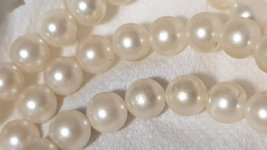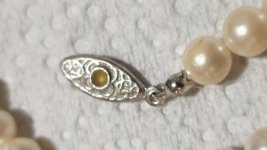Hi everyone!
Thank you in advance for any advice that you can offer - I've looked through some of the threads and it's a really great community you've got here.
So, I have absolutely no idea what pearls are supposed to look or feel like, but I went through the questions as per instructed:
1. Do the pearls feel slightly gritty or smooth when rubbed gently against another pearl (or against the edge of your tooth, if there is only one pearl?) Please rub gently!
If they are gritty, they are likely to be real nacre (genuine pearls.) If they feel smooth, they are likely imitation pearls.
1. To me they feel slightly gritty and not completely smooth. They are also quite cool to touch at first.
2. Please provide clear, in-focus photos without flash against a white background (a paper towel works nicely.)
Include close-ups of the clasp (front and back) and a few of the pearls. If there are flaws, include a photo of those. Also the box they came in, and tags if you have them.
3. I don't have much history to give other than they were owned by the mother of the lady who recently passed away - found in a jewellery box with some other items such as rings and some gold necklaces (a 9K and a 14K).
4. There are no marking on the clasp, just a small ornate clasp with some kind of a stone in it.
5. They all seem to be bewteen 5mm and 6mm
My inclination is to believe they are fake or cultured due to the similarity in the size and looking "too round" with not enough irregularity in the pearls, alas, I thought it was worth finding out what they may be!
Thank you in advance for any advice that you can offer - I've looked through some of the threads and it's a really great community you've got here.
So, I have absolutely no idea what pearls are supposed to look or feel like, but I went through the questions as per instructed:
1. Do the pearls feel slightly gritty or smooth when rubbed gently against another pearl (or against the edge of your tooth, if there is only one pearl?) Please rub gently!
If they are gritty, they are likely to be real nacre (genuine pearls.) If they feel smooth, they are likely imitation pearls.
1. To me they feel slightly gritty and not completely smooth. They are also quite cool to touch at first.
2. Please provide clear, in-focus photos without flash against a white background (a paper towel works nicely.)
Include close-ups of the clasp (front and back) and a few of the pearls. If there are flaws, include a photo of those. Also the box they came in, and tags if you have them.
3. I don't have much history to give other than they were owned by the mother of the lady who recently passed away - found in a jewellery box with some other items such as rings and some gold necklaces (a 9K and a 14K).
4. There are no marking on the clasp, just a small ornate clasp with some kind of a stone in it.
5. They all seem to be bewteen 5mm and 6mm
My inclination is to believe they are fake or cultured due to the similarity in the size and looking "too round" with not enough irregularity in the pearls, alas, I thought it was worth finding out what they may be!


